It is one of the rarest and most obscure releases of Sega’s Genesis era, to a point where many collectors even doubt its existence. It spearheaded a promotional campaign that somehow failed to manifest itself in the Western market, only to appear in the unlikeliest of places. And it was part of a movement that was considered back in its day to fundamentally change gaming itself, a game that pretty much vaporized like the entirety of its genre eventually would. This is the story of whatever became of an almost mythical, Brazilian exclusive release: The 32X CD version of the FMV rail shooter Surgical Strike.
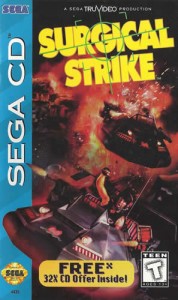 For some gamers in the current day and age, it might seem odd that someone would want to shine a spotlight on an obscure port of an unremarkable game, from an unpopular genre, and released on a failed platform; especially since nowadays, the originally released Sega CD release of Surgical Strike seems more like a footnote in the much-derided FMV genre. It is a very peculiar combination of events, however, of failed expectations, unrealized plans and unexpected circumstances that make Surgical Strike for the 32X CD a game of special interest, an artifact of the mid-1990s gaming landscape, a side branch of an era that promised so much, but somehow never left a lasting impression.
For some gamers in the current day and age, it might seem odd that someone would want to shine a spotlight on an obscure port of an unremarkable game, from an unpopular genre, and released on a failed platform; especially since nowadays, the originally released Sega CD release of Surgical Strike seems more like a footnote in the much-derided FMV genre. It is a very peculiar combination of events, however, of failed expectations, unrealized plans and unexpected circumstances that make Surgical Strike for the 32X CD a game of special interest, an artifact of the mid-1990s gaming landscape, a side branch of an era that promised so much, but somehow never left a lasting impression.
For many years, all that was known about the game was a photograph of some banged-up box and a short video clip of someone showing what appeared to be a 32X CD. Over the years, only two collectors had stepped forward claiming to own a copy of the game, and one of them sadly passed away, with the whereabouts of his copy remaining unknown. Now, with this article, we try to dig deeper and uncover more information about this particular obscurity.
The Best Laid Plans of Mice and Men…
To better understand, let us journey back to the mid-1990s. Sega and Nintendo are dominating the console landscape. By 1994, Sega had grown from a perceived underdog to a powerhouse that rivaled the juggernaut Nintendo for market share. But the times were changing. The Genesis, Sega’s leading console on the market, is beginning to show its age and lose some steam, while Nintendo is finally changing its direction due to the competition. At the same time, new companies, spurred on by the success of the House that Sonic Built and new technologies, are pushing into the market. Sega still had many fans and supporters but in order to stay in the game, it had to deliver something new to keep its edge.
With the debut of the Sega CD in 1992, Sega had already tried to usher in this new era. Technologically, the arrival of the CD medium promised a huge leap in the gaming landscape. More storage data, redbook audio, and the ability to actually play moving video as compared to sprite-based graphics seemed like a huge step up. In hindsight, low resolution movie clips on a limited color palette and gameplay reduced to simple button presses look archaic at best, but back in the day, it seemed like a milestone. However promising this new technology seemed though, it failed to pick up steam (for more insight into the how and why, check out our excellent feature, The Rise and Fall of FMV). Still, Sega, more specifically, Sega of America, was still standing tall, and even with the lack of success the Sega CD had to date, it wasn’t prepared to throw in the towel just yet. With new competition on the horizon, an upgrade in technology would bring a new push forward, ringing in new innovation while at the same time reinvigorating old platforms. This push would come in the form of a new add-on, the 32X!
Now, the reasoning behind the 32X, its release and its chances of success (or lack thereof) have been the cause for many debates, and this is neither here nor there. Still, even before this new add-on arrived, it was clear that in order to sell it, Sega needed a few launch titles that would showcase the strengths of the new technology. The prospect of FMV games still seemed like a good idea at the time. 1994’s critically acclaimed Wing Commander III showed what full-motion video could contribute to the overall video game experience. It made sense to utilize the strengths of the new add-on, namely more processing power and a greater power palette, to eliminate the weaknesses of the Sega CD to produce an exciting interactive movie that would push both the faltering hardware and the promising new add-on, thus prolonging the market superiority of the Genesis for a while longer.
The Gestation of Surgical Strike
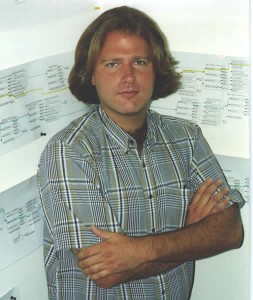
Enter TruVideo. Many people regard that term as “just” being the label Sega put on its FMV releases, but this isn’t quite correct. While some of the more infamous interactive movies released for the Sega CD were actually developed by a company called Digital Pictures, TruVideo was effectively a whole sub-department of SoA that was dedicated to producing original games for the Sega CD platform. Christopher Bankston, the former Executive Producer of Sega’s TruVideo line, remembers this time quite fondly. “The best part about being a producer at SEGA was that we owned our products once they were approved – we producers had final say on all matters regarding the product” he told Sega-16. “We had final say in every decision from beginning to end. I credit (the late) Joe Miller with making sure that was the case and it resulted in a lot of outstanding products from many talented producers. I think SEGA had an outstanding test department and all of the producers worked very closely with our counterparts in test. Those guys were awesome and deserved as much credit as possible in assisting with not only making sure the games were “bug free” but also pointing out improvements in game play.”
The first games produced by Sega under its new TruVideo brand were titles like Ground Zero Texas and Prize Fighter. These were basically movies where players had only a very limited influence. The first was more or less a shooting gallery disguised as a shooter, while the latter was a movie-style boxing game where players had to attack or defend at precise moments within the movie or there would be no change in the outcome. Though the movie-like experience was welcomed, even back in the day many magazines criticized the limited impact the gamers’ actions actually had upon the game. Surgical Strike, however, was to be different in that regard. Bankston remembered it as being one of his favorite productions. “The idea came from James ‘JR’ Riley of TouchTV. He was having margaritas and food with Sam Nicolson, of Stargate Films, and me at our favorite Mexican restaurant in Burbank; it was then that he pitched the idea. He had already put a rough script together and wanted to produce it with SEGA and Stargate. I had a discretionary budget for producing test titles so after listening to his pitch and looking at some rough material about his idea, I decided it would be worth testing out the concept and we moved forward. Marketing liked the test product and the rest, as they say, is history.”
As was common for TruVideo games, Bankston set up SEGA STUDIOS LA for SEGA in Beverly Hills, where he and his team planned and managed the production. Unlike other productions, however, the game was shot on digital video as well as film in order to ease production in later stages. The production itself was rather ambitious. Bankston explains: “The landscape and battlegrounds were scale models that were built in a very large soundstage at Stargate Films. We used robotic cameras programmed to sweep through the models in trails that matched the scripting. The hovercraft were full-scale, custom-built models that were mounted with real weapons. The craft were mounted on motion systems, like you would see at an amusement park, and the actors and craft were moving in front of a blue screen and directed by JR while he watched the footage shot by the cameras flying through the models.”
The result was, in a way, like an action-packed B-movie experience. In-game, the player steered a well-armed hovercraft-like vehicle through a maze-like warzone, trying to hunt down a terrorist and his mobile rocket launcher platforms. From a modern perspective, the game seems rather quaint, both technology and in terms of gameplay. The Sega CD version is still hampered by its single-speed drive, a palette of 64 merely onscreen-colors, and Ram restrictions, leading to small and grainy videos. And instead of full control over the vehicle, players may only fire their guns akin to a shooting gallery, as well as turn their hovercraft around at certain intersections or perform 180° turns when prompted. However, quite a few magazines noticed the ambition and the broader scope of Surgical Strike, especially when compared to other FMV games of the era. Instead of only getting to press certain buttons at opportune moments, being able to turn the hovercraft around seemingly at will and the high pace made the player feel more in control of the action than in other games of its kind. “Mean Machines Sega” gave the game a 72 rating – relatively high for a FMV game on the Sega CD, stating that “the action whizzes past at an intense rate, cinematics cutting in to enhance the visuals, and you’ve got to be quick on the trigger finger if you don’t want to take too many hits.” Sure enough, even though the videos are low resolution, the game feels like a cheesy B-movie extravaganza where explosions go off every other second. Of course, shooting on film came at a price. “I do recall that we had a minimum of two and a maximum of four outcomes at each branch (or event),”Bankston recalled, “and they varied depending on the script. These branches were at least close to 100 or more per game. I believe that the final minutes of video used in the games varied between 30-60 minutes. We shot four to six hours of footage, depending on the game, which is normal for that ratio. The people involved in a typical TruVideo game were between 100-150 cast, crew, programmers, etc. The total budget for Surgical Strike was about $2 million, which was quite a lot in 1994 dollars.”
As was the case with many TruVideo titles, programming was handled by the Leeds-based company, The Code Monkeys, a company Bankston says he helped create back during his time with Epyx. Since the video material was already shot digitally at a higher resolution than the Sega CD (even with added 32x support) was able to produce, down-rendering the clips wasn’t much of a problem.
The Push That Never Came
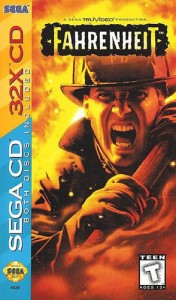 As already mentioned, when the 32X was nearing its own launch, Sega made the decision to enhance some of its Sega CD FMV games. Overall, six such 32X CD games were released. Four of them were games made by Digital Pictures: The infamous Night Trap, the shooter Corpse Killer, the lackluster sports game Slam City, and probably the nadir of all FMV games released on the platform, the abysmal fighter Supreme Warrior. Sega, on the other hand, had two games at hand, fresh out of the TruVideo pipeline. The firefighting interactive movie Fahrenheit got a single, special release in North America. Both the Sega CD game and its enhanced 32X version were released in a single package in that region. Players who only owned a Sega CD could just pop in the so-called “key disc” and play the game in its regular state. However, if the console registered a 32X hooked up as well, the same disc would prompt a message, urging the player to insert disc two instead, which contained the enhanced video. This was handled differently than with the four releases by Digital Pictures, where the Sega CD and 32X CD versions were separate entities entirely, which may have caused some confusion among many Sega fans. The lack of success of the 32X would result in Europe and Japan only receiving the single-disc Sega CD version of the game, though.
As already mentioned, when the 32X was nearing its own launch, Sega made the decision to enhance some of its Sega CD FMV games. Overall, six such 32X CD games were released. Four of them were games made by Digital Pictures: The infamous Night Trap, the shooter Corpse Killer, the lackluster sports game Slam City, and probably the nadir of all FMV games released on the platform, the abysmal fighter Supreme Warrior. Sega, on the other hand, had two games at hand, fresh out of the TruVideo pipeline. The firefighting interactive movie Fahrenheit got a single, special release in North America. Both the Sega CD game and its enhanced 32X version were released in a single package in that region. Players who only owned a Sega CD could just pop in the so-called “key disc” and play the game in its regular state. However, if the console registered a 32X hooked up as well, the same disc would prompt a message, urging the player to insert disc two instead, which contained the enhanced video. This was handled differently than with the four releases by Digital Pictures, where the Sega CD and 32X CD versions were separate entities entirely, which may have caused some confusion among many Sega fans. The lack of success of the 32X would result in Europe and Japan only receiving the single-disc Sega CD version of the game, though.
Surgical Strike would have gone a similar route, but Sega had bigger plans for this particular release. To give the 32X add-on a little push, only the disc containing the Sega CD version was published. This release contained a special promotion, advertised directly on the packaging. Interested players could send a card to Sega to receive the 32X disc for free, save some shipping costs. The game would have worked in a similar fashion to Fahrenheit. The Sega CD version would still be needed as a key disc, while the second disc would only hold the 32X content and would only play when the Sega CD disc was inserted first. At about the same time the promotion took place in the U.S. on the Sega CD game’s packaging, European magazines were running ads for the whole 32X package, hinting at an intended 32X CD exclusive release overseas.
However, the 32X CD version of the game never materialized. No promotional 32X CDs were given out in the U.S., nor did the game see release in any form in the European market. Inside sources from former European Sega departments state that while they were told to run the ads, they never actually received any copy of the game themselves. The reasons behind that aren’t clear-cut, but three partially intertwining factors may have led to the decision to shelve the release:
- By 1995, FMV games in general went into decline. The reasons were many. Interactive movies usually got lambasted by the press, not only for their limited gameplay, but also due to the reception of their content. In 1994, four titles in Entertainment Weekly’s “most violent games” list were FMV games. Also, while filming resulted in rather high production costs (as mentioned above), players had eventually become bored with the genre, since most entries were similarly styled movies with limited interactivity, little run time and limited replay value.
- Fahrenheit, the other TruVideo 32X CD release, didn’t sell particularly well on its own.
- The promotion didn’t find many takers – most people were wary of getting another add-on for their console, and so most buyers probably wanted to wait whether the 32X would eventually be worth the investment. It wasn’t, seeing as the 32X was discontinued in 1996, less than 18 months after its introduction. North American support for the Sega CD was also cut in 1995.
Unfortunately, it isn’t quite clear what Sega had in mind when promoting the game. Of those in marketing who could be contacted, nobody could remember what the plans for the game were in particular or how well or badly it performed. It appears that this promotion was intended as (part of?) a final push for the Genesis add-ons, one that was cut short when the market folded and the decision was made to pull the plug, first on the Sega CD and then on the 32X shortly thereafter. Whatever the case, Surgical Strike, even with its ambition and its relatively warm reception by contemporary critics, wasn’t a success. The plans for a North American release of the 32X CD version were scrapped, and other regions never even got a copy for their own archives, let alone publication… or so it would seem!
An Unlikely Market
As is quite often the case, one region usually gets overlooked when looking back on release history, South America! During the 1980s, Brazil was a market of considerable interest; not all that surprising if you consider that it actually is the fifth-largest country in the world, both by geography and by population. However, the 1980s weren’t very kind to Brazil. While the economy had grown in the decades before, this had come at the cost of an increase in debt. When the nation entered the ’80s, it ran into economic struggle. People hardly could afford originally licensed products, especially when it came to the still infant console and computer markets. As a result, piracy ran rampant. Nintendo had to learn that the hard way. When it tried to introduce the NES to South America, it faced a fierce competition – by itself! Rather, by all the Famiclones that had already reached the market before Nintendo had tried to establish a base of its own.
When Sega first tried to distribute the Master System worldwide, it tried to partner with other local businesses to gain a foothold. In North America, this strategy backfired. Nintendo already held 90% of the market and the partner, Tonka, had no experience with video games and utterly failed to place the product properly. The Canadian partner, Irwin Toy, fared little better.
In Brazil however, with its large but economically difficult market, the move turned out to be a success. TecToy not only knew the market but managed to avoid the pitfalls Nintendo ran into. Buying a Master System meant you got an original console, not a clone of dubious quality. One can say that Tec Toy knew its respective market better that Tonka did in the U.S.; Tec Toy managed to gear the product more towards local tastes, for example, by modifying certain games with local licenses (like issuing Wonder Boy in Monster Land in a version with characters from the popular A Turma da Mônica comic series). Faced with a market ripe with unlicensed pirate clones, Tec Toy, by its own accounts, managed to eke out a market share of 70-80% with its 100% licensed Sega hardware that was in some cases even manufactured locally. Keep in mind, this partnership with Tec Toy was also formed before the foundation of international Sega subsidiaries like Sega Europe. In dealing with a difficult market but nevertheless proving successful, Tec Toy gained a certain leeway when marketing Sega products for the South American Mercosur region, probably more than other Sega subsidiaries, which had to follow a chain of command leading to SoA or SoJ, ever got themselves.
Tec Toy also successfully handled the release of the Mega Drive. Covering the lion’s share of the console market in South America and having gained the buyers’ trust in that region, it was practically uncontested in fulfilling the 16-bit demands of the population. Nintendo officially entered the Mercusor market in 1993, at a time when Tec Toy had already dominantly established the Mega Drive, with the Master System still going strong as a low-tech, low-cost alternative.
Still, faced with other 16-bit competition, Tec Toy decided to diversify, and so the decision was made to introduce the Genesis add-ons to the Brazilian market as well. Stefano Arnhold, Tec Toy’s CEO during that time, explained it to Sega-16. “Basically, we wanted to differentiate Mega Drive from its Nintendo 16-bit rival. This is the main reason for launching Sega CD and 32X. Once both add-ons were on the market we tried to serve our consumers by offering them as much software as possible.”
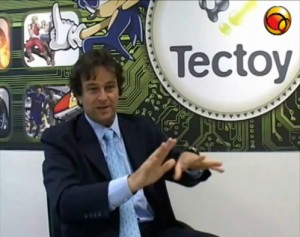 Introducing the Sega CD and the 32X weren’t the only measures in that regard. Tec Toy also offered the Sega Club, a sales channel aimed directly at the end customer avoiding retail, in which Tec Toy offered a CDX bundled with Night Trap and two other games as special sales deal, among other things. According to Arnhold, something between 10 and 20 thousand units were being sold in Brazil this way. Tec Toy also offered a popular official hot line (handling more than 50,000 calls a month), and even the Mega Net found its way to Brazil. “In our effort to differentiate Mega Drive,” Arnhold explained, “we launched a home banking system with Brazilian largest private bank (Banco Bradesco) and Mega Net II, where you could play head-to-head with other Mega Drive owners thousands of kilometers away. It also had home shopping capabilities, plus chat, etc.”
Introducing the Sega CD and the 32X weren’t the only measures in that regard. Tec Toy also offered the Sega Club, a sales channel aimed directly at the end customer avoiding retail, in which Tec Toy offered a CDX bundled with Night Trap and two other games as special sales deal, among other things. According to Arnhold, something between 10 and 20 thousand units were being sold in Brazil this way. Tec Toy also offered a popular official hot line (handling more than 50,000 calls a month), and even the Mega Net found its way to Brazil. “In our effort to differentiate Mega Drive,” Arnhold explained, “we launched a home banking system with Brazilian largest private bank (Banco Bradesco) and Mega Net II, where you could play head-to-head with other Mega Drive owners thousands of kilometers away. It also had home shopping capabilities, plus chat, etc.”
Lamentably, Brazil still faced both economic and political turmoil. Inflation was rampant, and at the beginning of 1990, the GPI fell a staggering 80%. As such, not many people were able to afford these expensive add-ons. After talking about this with a few Sega-16 members living in Brazil, one of them recalled “when the 32X was released in Brazil it cost BRL 400.00, and, at the time, 1 BRL == 1 USD. […] [ed: according to historical data, the exchange rate between dollars and Real was roughly at 0.96 in late October 1995 – source]. By the end of 1994 the MD cost around BRL 250.00-300.00 at retailers, so in order to have a 32X you’d have to invest around USD 700.00 in Brazil. I don’t remember the Sega CD price at the time, but it might have been sold by something like BRL 350.00 at the time, so it was a USD 1000.00 investment in a time where the official minimum wage in Brazil was USD 100.00!”
When asked for sales figures, Arnhold confirms that the Mega Drive add-ons didn’t even fare as well as the Mega Drive itself. “The 32X adapter was not a popular Mega Drive add-on and we sold around 3000 units. We sold around six thousand 32X cartridges of 14 different titles: Star Trek, Virtua Racing, Star Wars, Virtua Fighter, Doom, Blackthorne, Mortal Kombat II, Kolibri, Super Motocross, Cosmic Carnage, Metal Head, Golf Magazine, Knuckles Chaotix and Tempo. The Sega CD sold about 30k units and a total of roughly 50k CD games. We launched the 32X with different games bundled with the accessory: Metal Head, Mortal Kombat II and Doom.”
With only 30.000 Sega CD units and roughly 1/10 of that number being 32X units sold, demand for CD32X units was slim indeed. Tec Toy, however, still had access to the Sega library and thus decided to release both 32XCD titles produced by the TruVideo line in Brazil anyway. Both releases were 32X/CD combo releases: CD1 served as the Sega CD stand-alone and as “key” disc, while disc two held the 32X game (and needed the key disc for startup). Arnhold was kind enough to provide the release dates from the Tec Toy archives. Thus, he could confirm that yes, Surgical Strike 32XCD was indeed officially released in Brazil: “I can confirm that we launched at least two CD 32X titles,” he explained. (995.157.010.829) CD 32X Fahrenheit and (995.157.036.832) CD 32X Surgical Strike. The number before the name is our product code, where ‘157’ stands for 32X CDs.”
So there you have it, confirmation from the highest order. Yet even with such a narrow market, Surgical Strike 32XCD did indeed see official release, but how many copies actually exist in the wild? Well, let’s hear it from señor Arnhold himself one more time:
“Fahrenheit 32X CD was launched in June 1995, and Surgical Strike 32X CD was launched in January 1996. Each has sold around 500 units.”
At Journey’s End
With this official confirmation at hand, it is safe to say that, with approximately 500 units sold worldwide, the 32X CD port of Surgical Strike did indeed find an official release, but it surely is a rare beast. Hunting down a copy of the game may be an insurmountable task, although another forum member was able to hunt down a copy of the official manual and was able to provide a few pictures. Would it be worth it? Well, by all accounts, the experience would be the same as it’d be with the North American release of Fahrenheit, A graphically enhanced version of the same game with more colors and a slightly better framerate, sold in the same combo package, needing both the Sega CD and the 32X disc to run. Gameplay-wise, it might not be the greatest package – but one that contains quite a lot of history.
Thanks in creating this feature go out towards: Christopher Bankston (former executive producer of TruVideo) and Stefano Arnhold (former CEO of Tec Toy Brazil) for their time and patience in answering my question; Steve Payne and Haven Carter (formerly of Sega of America) as well as Mark Kirkby (founder of The Code Monkeys) and Colin Hogg (lead programmer of Surgical Strike) for trying to assist, even if they couldn’t remember many details; and Sega-16 members goldenband, Barone and RebirfH for their insight in both the Brazil market situation and the collector’s POV.

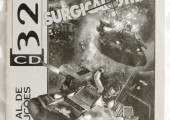
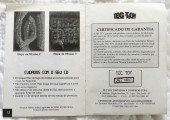
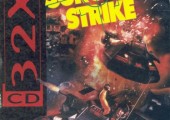
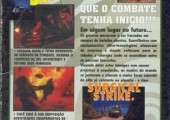
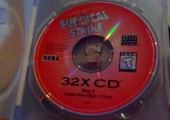
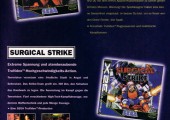
Pingback: With Developer Commentary – Surgical Strike (Sega CD, ’93) - Dave Voyles | Tech Evangelist at Microsoft
What an rich article. As a 32-year-old brazilian it is nice to revisit these eventos from another perspective, since I was only a young player owner of the mostra parte of the Sega TecToy consoles… I got my Sega CD eith a high costa only in 1995, and by that time it was amazing.
Thanks for such a nice article.